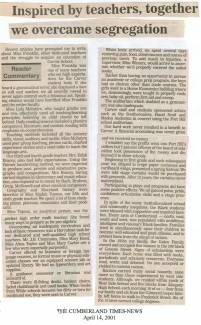Collection Name
About
Inspired by teachers, together we overcame segregation
Recent articles have prompted me to write about Miss Franklin, other dedicated teachers and the struggle to acquire an education at Carver School.
Reader Commentary
Miss Franklin was one of many teachers who set high expectations for the Carver student body. If she heard a grammatical error, she displayed a face so soft and somber, we all secretly vowed to never again commit such a felonious act. Speaking ebonies would have horrified Miss Franklin and the entire faculty.
Miss Lela McIntyre, who taught grades one and two, effectively used all teaching/learning principles, believing no child should be left behind. Daily reading lessons included a phonics component, literature, and content reading with emphasis on comprehension.
Teaching methods included all the sensory skills, visual, auditory and tactile. Miss McIntyre used peer group teaching, phrase cards, charted experience stories and a sand table to teach the language arts.
Our third and fourth grade teacher, Mrs. Edith Bracey, also had lofty expectations. Using the Palmer handwriting method, we were expected to produce neat, precise and substantive paragraphs and compositions. Mrs. Bracey, having earned degrees in elementary and music education, also exposed us to music by Bach, Brahms, Greig, McDowell and other classical composers.
Geography and Maryland history were favorites of Miss Madah Topson, our fifth and sixth grade teacher. We spent a lot of time studying plains, plateaus, mountains and their products.
Miss Topson, an analytical person, was the perfect high order math teacher. She found many ways to prepare us for pre-algebra.
Overcoming an inadequate curriculum and lack of basic resources was a Herculean task for our dedicated and well-qualified high school teachers. Mr. J.B. Clemmons, Miss Mary Reed, Miss Alma Taylor and Miss Mary Carter are a few who were especially purposeful.
Carver offered no business or foreign language courses, no formal music or physical education classes nor an equipped science lab or updated library. We had no typewriters and art supplies.
A guidance counselor or librarian was unheard of.
There were ill-fitting desks, broken chairs, faded chalkboards and used books. When books from White schools became too dirty or torn for continued use, they were sent to Carver.
When texts arrived, we spent several days removing gum, food, dried mucous and names of previous users. To add insult to injustice, a supervisor, Miss Winters, would arrive to ascertain whether we'd properly covered the soiled books.
Rather than having an opportunity to pursue an academic or college prep program, the boys had no choices other than trade courses. The girls went to a Home Economics building where we, demeaningly, were taught to properly cook, sew, baby-sit, perform first aid and sweep.
The auditorium which doubled as a gymnasium was also inadequate.
Carver staff and students sponsored artists such as the Southernaires, Hazel Scott and Marian Anderson in concert using the Fort Hill school auditorium.
Our hard work never resulted in a benefit to Carver. A financial accounting was never given and we received no money.
I wouldn't say the profits went into Fort Hill's coffers but I assume officers of the board of education took possession of the money and disbursed it to other schools.
Beginning in first grade and each subsequent year, we, draped in crepe paper costumes and cardboard wings, presented a spring festival. We were told stage curtains would be purchased with proceeds. After 12 years, the curtains never materialized.
Participating in plays and programs did have some positive effects. We all gained poise, pride, confidence articulation skills and a stage presence.
In spite of the many institutionalized school and community inequities, the Black students were blessed with supportive and inspired families. Every area of Cumberland — north, east, south and west, was populated with ambitious, intelligent and visionary Black families. Families tried to simultaneously raise their children to become well-educated and good citizens, and to protect them from the stings of racism.
In the 1950s my family, the Gates Family, owned and occupied five houses in the 500 block of Greene Street. Signs of scholarship were everywhere. Each home was filled with books, periodicals and scholarly resources. Everyone read, wrote and debated. No one accepted or yielded to societal racism.
Racism carried many social hazards; none more so than those experienced by west side students. Although, we resided within yards of West Side School and five blocks from Allegany High School, each morning 10 of us — four from my family and six from the Gilmore/Cooper family, left home to walk to Frederick Street. Six of the 10 later earned college degrees.
The next barrier was the Western Maryland Railroad's Baltimore Street crossing. There we usually encountered a moving train. We waited and fidgeted because a school tardy meant no recess. But the most dangerous situation occurred at the Frederick Street B&O crossing, where we were, inevitably, met by two long coal-laden trains standing on the tracks for as long as half an hour. There we'd stand in near zero temperature, through sleet, snow, torrential rain or flashing lightening.
The boys would often dangerously climb through the train hoping the second train would soon move.
I didn't see much bitterness in our school setting. There was esprit de corps. We were bonded through school activities, admiration for our teachers respect and fondness for each other, a youthful exuberance and visions of a happy future.
Recently, I received correspondence from the committee to preserve Carver. My reaction was mixed. I initially wanted to see this vestige of segregation and devalued personhood replaced with a modern and state-of-the-art facility for 21st century youth.
Deeper reflection, however, compels me to support saving Carver School as a monument to caring teachers, the indomitable spirit of the Cumberland Black community and as a testament to the rocky road we trod.
Dolores Gates-Thomas
Washington, D.C.
Cumberland Times-News
